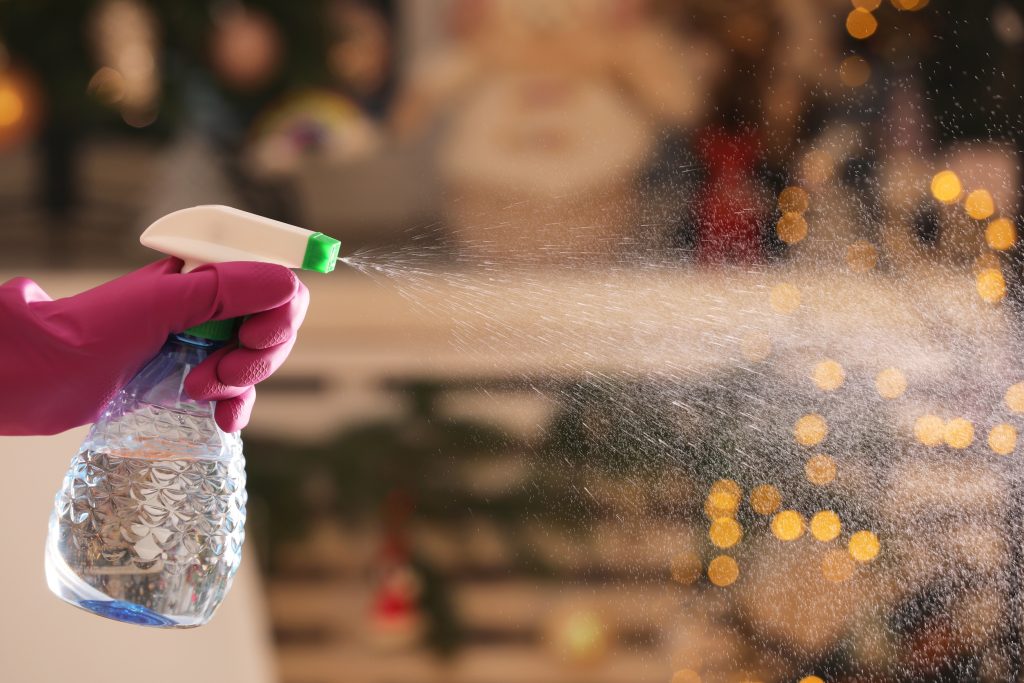
That sparkling clean scent filling your home after a deep clean might feel satisfying, but what if it’s coming at a hidden cost to your health? Many of us grab household cleaners off the shelf without a second thought, trusting they are safe. However, countless common products release volatile organic compounds (VOCs) and harsh chemicals into the air. Understanding which cleaning products harm your lungs is the first step toward creating a safer, healthier home environment without sacrificing cleanliness. You’ll be surprised to learn which everyday items pose a potential risk to your respiratory system.
1. Bleach
Bleach is a powerful disinfectant, but its main ingredient, sodium hypochlorite, is a significant respiratory irritant. When you use bleach, it releases chlorine gas, which can cause coughing, shortness of breath, and chest pain, especially in poorly ventilated areas. More importantly, never mix bleach with ammonia-based cleaners. This combination creates chloramine gas, a highly toxic substance that can cause severe lung damage, fluid in the lungs, and even death. Always ensure proper airflow by opening windows and using a fan when handling bleach.
2. Ammonia-Based Cleaners
Found in many glass cleaners and multi-purpose sprays, ammonia is effective at cutting through grease and grime. However, its fumes are extremely harsh on the respiratory system. Inhaling ammonia can irritate the sinuses, throat, and lungs, leading to coughing and burning sensations. For individuals with asthma or other respiratory conditions, exposure can trigger a severe attack. As mentioned, the danger multiplies when mixed with bleach, making it crucial to read labels carefully.
3. Air Fresheners and Deodorizers
That pleasant “ocean breeze” or “spring meadow” scent often comes from a cocktail of chemicals, including phthalates. These chemicals are used to make fragrances last longer but are known endocrine disruptors and can exacerbate asthma. When sprayed, these air fresheners release fine particles that can lodge deep within the lungs, causing inflammation and long-term damage. Instead of masking odors with chemicals, try natural alternatives like essential oil diffusers or simply opening a window.
4. Oven Cleaners
The baked-on grease in an oven requires some heavy-duty cleaning power, which often comes from caustic chemicals like sodium hydroxide (lye). When sprayed, these corrosive ingredients can become airborne, posing a serious risk if inhaled. The fumes can burn your nasal passages, throat, and lung tissue, leading to extreme respiratory distress. Always wear a mask and gloves and ensure your kitchen is fully ventilated when using these powerful degreasers.
5. Carpet and Upholstery Shampoos
Carpet cleaners often contain solvents and surfactants designed to lift dirt, but they can leave behind chemical residues that off-gas for hours or even days. Ingredients like naphthalene and formaldehyde, both potential carcinogens, can be released into the air you breathe. This is particularly concerning in homes with children and pets who spend more time close to the floor. Proper ventilation during and after cleaning is essential to minimize exposure.
6. Drain Cleaners
Drain cleaners are formulated with some of the most corrosive chemicals available, such as sulfuric acid or lye, to dissolve hair and grime. When poured down a drain, they can react with water and other substances to release toxic fumes. Accidentally inhaling these fumes can cause immediate and severe damage to the lining of your lungs. It is far safer to use a mechanical drain snake or a mixture of baking soda and vinegar for routine clogs.
7. Furniture Polish
Many furniture polishes and waxes contain flammable hydrocarbons like petroleum distillates. These substances can give wood a beautiful shine, but they also release VOCs that irritate the respiratory tract. Inhaling these fumes can lead to nausea, dizziness, and long-term lung sensitivity. Look for wax-free polishes or use a simple microfiber cloth with a small amount of olive oil and lemon juice for a natural shine.
8. Glass and Window Cleaners
While often ammonia-based, some glass cleaners use other solvents like 2-butoxyethanol to achieve a streak-free shine. This particular chemical can contribute to sore throats and, with high exposure, more severe conditions like pulmonary edema. The fine mist from a spray bottle makes these chemicals easy to inhale, so spraying the cloth instead of the glass can help reduce airborne particles.
9. Toilet Bowl Cleaners
Acidic toilet bowl cleaners use ingredients like hydrochloric acid to dissolve mineral stains and kill germs. These formulas can release pungent fumes that irritate the eyes, skin, and respiratory system. If these cleaners are accidentally mixed with bleach-based products, the resulting chemical reaction can produce dangerous chlorine gas. Always clean in a well-ventilated bathroom and never mix different cleaning agents.
10. All-Purpose Sprays with “Fragrance”
The simple word “fragrance” on a label can hide hundreds of different chemicals, none of which are required to be disclosed. These proprietary blends often contain VOCs and allergens that can trigger respiratory issues. If you are sensitive to smells or have asthma, opt for fragrance-free versions or make your own all-purpose cleaner with vinegar, water, and a few drops of essential oil.
Protect Your Lungs While You Clean
Creating a clean home shouldn’t compromise your respiratory health. By being mindful of which cleaning products harm your lungs, you can make smarter choices. Opting for natural alternatives, ensuring proper ventilation, and always reading ingredient labels are simple but powerful ways to protect yourself and your family. Your lungs will thank you for reducing their exposure to these harsh and unnecessary chemicals.
What are some of your favorite natural cleaning alternatives that work just as well as store-bought products? Share your tips in the comments below!
Read more:
8 Harmful Products That Could Be Using Daily In Your Home
13 Products That Are Perfect for Tiny Apartments
The post 10 Cleaning Products That Quietly Harm Your Lungs appeared first on Budget and the Bees.







